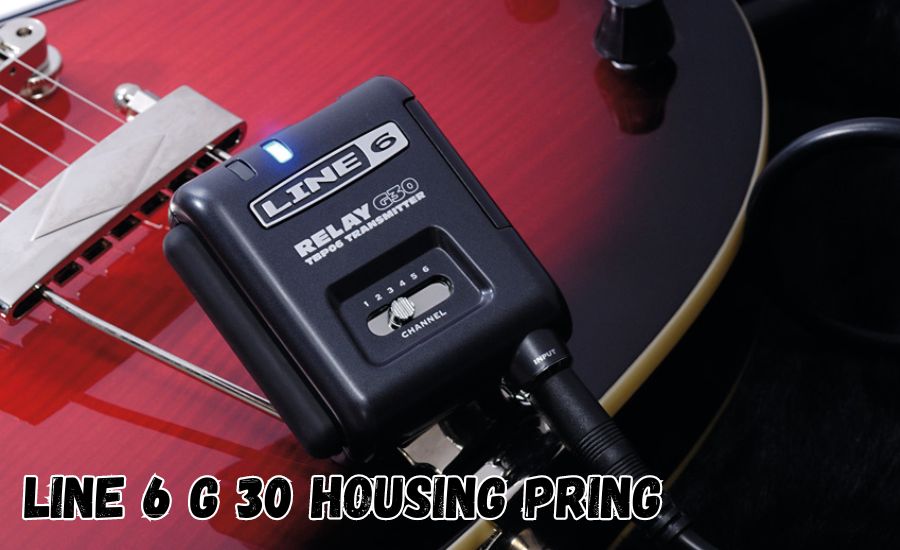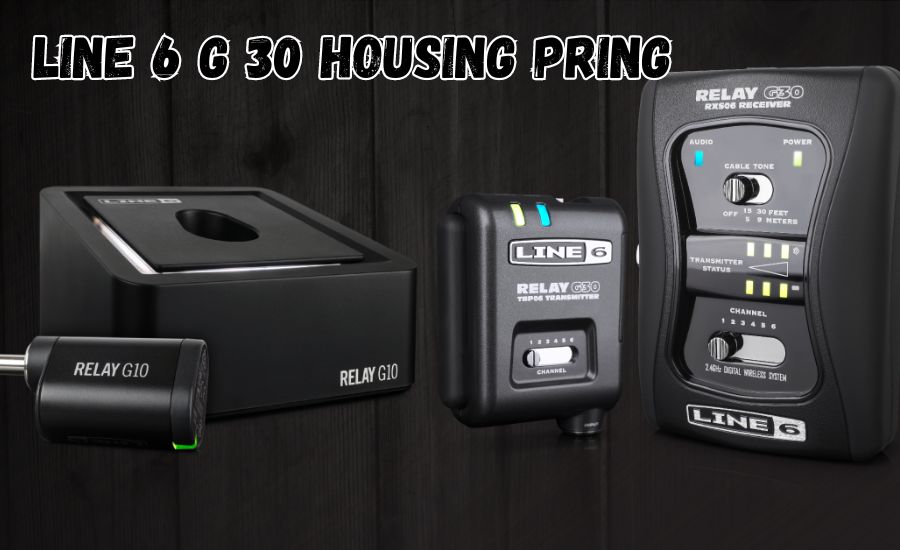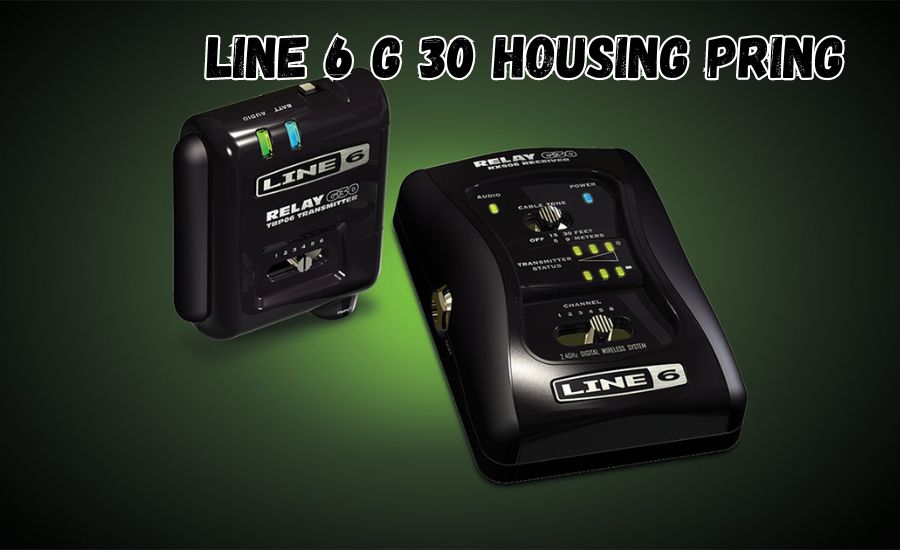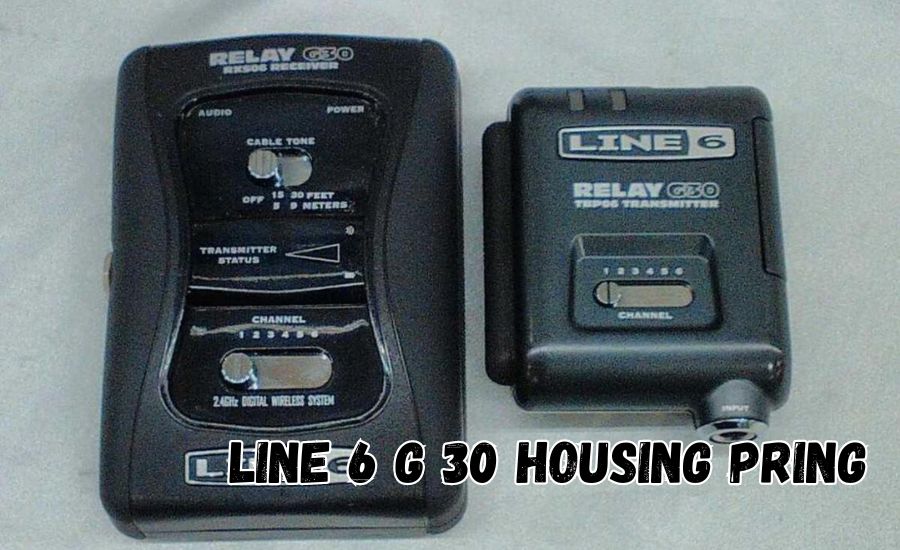Line 6 G30 housing print is a popular solution for musicians who want to protect their wireless systems. With the line 6 G30 housing print, you can easily make your device look cooler while keeping it safe from damage. This print provides extra protection for your G30 transmitter, giving it a longer life.
Many musicians worry about their equipment getting scratched or damaged during shows or practice. The line 6 G30 housing print not only protects your device but also makes it stand out with a custom design. In this blog, we’ll explore how this housing print works, why it’s important, and how you can create your own.
What is Line 6 G30 Housing Print and Why You Need It
The Line 6 G30 housing print is a 3D-printed cover designed to protect the Line 6 G30 wireless system. This cover keeps your device safe from scratches, bumps, and other damage that can happen when you’re on stage or practicing. It’s a simple way to make sure your equipment lasts longer.
Not only does it protect your wireless system, but the Line 6 G30 housing print also allows for customization. You can choose different designs and colors to match your style or band. This makes it stand out and gives your gear a personal touch, while still keeping it safe and secure.
Using a housing print like this means less worry about accidents. You won’t have to keep replacing broken gear, saving you money in the long run. Plus, the lightweight material won’t add extra weight to your setup, making it perfect for musicians on the go.
How Line 6 G30 Housing Print Can Save Your Wireless System
The Line 6 G30 housing print provides a strong layer of protection for your wireless system. When you’re performing or rehearsing, your equipment can easily get knocked around. With this housing print, you don’t have to worry about damaging your device.
Accidents happen, especially during live shows. But with the Line 6 G30 housing print, you can keep your wireless system looking new. The print shields the G30 transmitter from scratches, drops, and everyday wear and tear. This way, you can focus on playing, not on your equipment.
By using a housing print, you can extend the life of your wireless system. Instead of replacing your gear after each accident, the housing print absorbs the damage. This makes it a cost-effective solution for protecting your investment.
Step-by-Step Guide to Printing Line 6 G30 Housing
If you’re interested in creating your own Line 6 G30 housing print, the process is simple. First, you’ll need access to a 3D printer. Many online platforms offer free designs that you can download and customize to your needs.
Choosing the Right Design
When selecting a design, make sure to choose one that fits your G30 transmitter perfectly. There are many different designs available, so you can pick something that suits your style. You can also adjust the colors and patterns to match your setup.
Printing and Installing the Housing
Once you’ve chosen your design, upload it to the 3D printer software and print your housing. After printing, the housing snaps onto your Line 6 G30 transmitter, giving it an extra layer of protection. This do-it-yourself approach is fun and affordable, allowing you to create custom gear without spending a lot of money.
Top 5 Reasons to Use Line 6 G30 Housing Print for Your Gear
There are many reasons to use a Line 6 G30 housing print for your gear. First, it offers strong protection against scratches and damage. You won’t have to worry about breaking your wireless system when you’re on the move or performing.
Secondly, the Line 6 G30 housing print allows for easy customization. You can choose different colors and styles to make your gear stand out. This is great for musicians who want to add a personal touch to their equipment.
Cost-Effective Protection
Another reason is that it’s cost-effective. Instead of buying expensive protective gear, you can 3D print your own housing cover. It’s a smart investment that saves you money in the long run.
Lightweight Design for Convenience
Plus, the lightweight design won’t add extra bulk to your setup. It makes it easy to carry your gear without extra weight, ensuring that your wireless system is well-protected and convenient for travel.
Protect Your Equipment with Line 6 G30 Housing Print
Protecting your equipment is essential for every musician, and the Line 6 G30 housing print makes this easy. This 3D-printed cover provides a durable shield for your G30 transmitter, keeping it safe from damage during use.
When you use the Line 6 G30 housing print, you give your wireless system a protective layer that absorbs impact. Whether it’s a drop or a scratch, the housing print reduces the risk of damage. It’s a practical solution that ensures your equipment stays in good condition.
Avoid Costly Repairs
Your gear is an investment, and protecting it with a housing print helps you get the most out of it. You can avoid costly repairs or replacements by using this simple and effective solution. Plus, it looks great and adds personality to your setup.
The Benefits of Customizing Your Line 6 G30 Housing Print
Customizing your Line 6 G30 housing print allows you to personalize your gear while adding protection. It not only keeps your wireless system safe but also lets you show off your style. Musicians often like to add a touch of personality to their equipment, and a custom print is a great way to do this.
Stand Out on Stage
When you customize your Line 6 G30 housing print, your gear will stand out. Instead of blending in with standard equipment, your device will be unique. This is especially useful during performances where you want to be noticed.
Match Your Band’s Aesthetic
Customization allows you to create a design that matches your band’s style. Whether you prefer bold colors or subtle designs, you can easily adjust the look of your housing print to reflect your musical identity.
How to Get the Perfect Line 6 G30 Housing Print for Your Setup

Getting the perfect Line 6 G30 housing print involves a few key steps. You need to choose the right design, select a suitable material, and ensure the print fits your transmitter perfectly. With the right approach, your print will look great and provide excellent protection.
Selecting the Right Design
Start by choosing a design that complements your gear. You can either download a ready-made design or create your own. Consider the color and style of your setup when picking a design to ensure everything looks cohesive.
Ensuring Proper Fit
Make sure the dimensions of the housing print are accurate. A well-fitted print will securely snap onto your G30 transmitter, providing protection without interfering with its performance. Double-check the measurements before printing to avoid any issues.
Line 6 G30 Housing Print: An Easy Way to Keep Your Device Safe
The Line 6 G30 housing print is one of the easiest ways to keep your wireless system safe. This 3D-printed cover provides a shield against bumps, drops, and scratches, ensuring your gear stays in top condition. Musicians who travel or perform frequently can benefit from this extra protection.
Simple and Affordable Solution
Unlike expensive protective cases, the Line 6 G30 housing print is an affordable and effective solution. It doesn’t require a big investment, and you can create a custom design that fits your needs. With just a little effort, you can print a cover that keeps your gear safe.
Easy to Use and Install
Installing the housing print is simple. It snaps onto the G30 transmitter without any tools, making it a convenient option for musicians who need quick and easy protection. Once installed, you can feel confident that your device is secure.
Designing a Unique Line 6 G30 Housing Print for Your Band
Designing a unique Line 6 G30 housing print for your band is a fun and creative process. With the ability to choose different colors, patterns, and logos, you can create a housing print that represents your band’s identity. Whether you want something bold or minimalistic, the possibilities are endless.
Adding Your Band’s Logo
One way to personalize your housing print is by adding your band’s logo. This creates a professional look and makes your equipment easily recognizable. Many bands choose this option to create a cohesive aesthetic across their gear.
Choosing Custom Colors
You can also select colors that match your band’s theme. Whether you prefer bright, eye-catching colors or a sleek, monochromatic look, the Line 6 G30 housing print allows you to make your gear truly yours.
How to Install Line 6 G30 Housing Print: A Beginner’s Guide
Installing the Line 6 G30 housing print is easy, even if you’ve never worked with 3D-printed materials before. The print is designed to snap onto your G30 transmitter, providing instant protection. In this guide, we’ll walk you through the simple steps to get your housing print installed.
Preparing Your Transmitter
Before installing the housing print, make sure your G30 transmitter is clean and free of dust. This ensures that the print fits properly and securely. Wipe down the device with a soft cloth if needed.
Attaching the Housing Print
Gently snap the Line 6 G30 housing print onto the transmitter. The print should fit snugly without any gaps. Make sure all parts of the transmitter are covered by the housing for full protection. Once attached, your device is ready to go!
Can Line 6 G30 Housing Print Improve Your Gear’s Durability?
The Line 6 G30 housing print significantly improves the durability of your wireless system. It acts as a protective shield, absorbing impact and preventing damage from everyday use. Musicians who frequently perform or travel will benefit from the added protection this print provides.
By covering the transmitter with a strong 3D-printed material, the housing print reduces the risk of damage. Even small accidents, like drops or bumps, are less likely to affect your device. This extends the life of your equipment and saves you from costly repairs.
Using a housing print also means that your gear remains in better condition over time. The protective cover prevents scratches and wear, keeping your transmitter looking new. With the Line 6 G30 housing print, you can ensure that your gear is always ready for the next gig.
Why Every Musician Should Use a Line 6 G30 Housing Print
Every musician should consider using a Line 6 G30 housing print for their wireless system. This 3D-printed cover adds protection and a personal touch to your equipment. Whether you’re performing live or practicing at home, having a housing print helps keep your gear in top condition.
Protection for Frequent Performers
If you’re constantly on the move, your equipment is likely to get knocked around. A Line 6 G30 housing print can absorb these impacts, keeping your wireless system safe from scratches and damage. This is crucial for musicians who travel and perform regularly.
Affordable and Customizable
The housing print is also a budget-friendly option. Instead of spending money on expensive cases, you can print a custom cover that reflects your style. You can choose different colors and designs to make your gear stand out, all while protecting it
Read Next: Pioneer-Avic-Install-For-2004-Corvette.
How to Choose the Best Material for Line 6 G30 Housing Print

Choosing the right material for your Line 6 G30 housing print is important for ensuring durability and protection. Some materials are more flexible, while others offer extra strength. The material you choose will depend on your specific needs and preferences.
PLA vs. ABS for Durability
PLA is a popular 3D printing material because it’s easy to use and environmentally friendly. However, ABS is stronger and better at handling heat, making it a good choice if you’re looking for extra durability. Both materials are widely available and suitable for printing your Line 6 G30 housing.
Considering Flexibility and Strength
If flexibility is important to you, TPU is another option. It’s a rubber-like material that can absorb impacts more effectively than rigid materials. For musicians who want to protect their gear from drops and knocks, TPU might be the best choice for a housing print.
3D Printing Your Own Line 6 G30 Housing: What You Need to Know
3D printing your own Line 6 G30 housing is an exciting and affordable way to customize your gear. With a 3D printer, you can create a cover that fits your transmitter perfectly and reflects your personal style. Before getting started, there are a few things you need to know.
Setting Up Your 3D Printer
First, ensure your 3D printer is properly calibrated. Accurate calibration is essential for creating a housing print that fits snugly on your Line 6 G30 transmitter. You’ll also need to download or create a 3D model of the housing design, which you can easily find online.
Choosing the Right Design
Once your printer is set up, choose a design that matches your needs. You can opt for a simple cover or add creative touches like your band’s logo. Once printed, the housing will snap onto your transmitter, offering both protection and a custom look.
Common Mistakes to Avoid When Printing Line 6 G30 Housing
When creating a Line 6 G30 housing print, there are a few common mistakes you should avoid. By knowing these pitfalls, you can ensure your print turns out perfectly and fits your wireless system as it should.
Incorrect Sizing
One of the most frequent mistakes is incorrect sizing. If the dimensions are off, the housing won’t fit properly on your transmitter. To avoid this, double-check the measurements and use precise settings in your 3D printing software.
Using Low-Quality Material
Another mistake is using low-quality 3D printing material. Cheap materials may not offer the durability needed to protect your device. Invest in high-quality PLA, ABS, or TPU to ensure your Line 6 G30 housing print provides long-lasting protection.
How Line 6 G30 Housing Print Enhances Performance and Protection
A Line 6 G30 housing print does more than just protect your gear—it can also enhance the performance of your wireless system. The housing acts as a shield, preventing damage that could affect the functionality of your equipment. With the right housing print, your gear stays in optimal working condition.
Protection from Physical Damage
The main benefit of using a housing print is the added protection. Whether you accidentally drop your device or it gets scratched during transport, the housing absorbs the impact. This reduces the chances of internal damage, ensuring your G30 transmitter continues to perform well.
Prolonged Device Lifespan
With the extra protection from a housing print, your wireless system is likely to last longer. You’ll spend less on repairs or replacements, and your gear will remain in better condition over time. This makes the housing print a smart investment for any musician.
Best Practices for Maintaining Your Line 6 G30 Housing Print
Maintaining your Line 6 G30 housing print ensures that it continues to protect your wireless system effectively. With proper care, your housing print can last a long time and keep your gear safe from damage.
Regular Cleaning
One of the best ways to maintain your housing print is by cleaning it regularly. Dust and dirt can accumulate on the surface, especially if you use your equipment frequently. Use a soft cloth to wipe down the housing and remove any debris that could affect its performance.
Avoid Exposure to Extreme Conditions
Exposing your housing print to extreme heat or cold can cause the material to warp or crack. To prevent this, store your gear in a temperature-controlled environment when not in use. This helps keep the housing in good shape and ensures your wireless system remains protected.
Custom Line 6 G30 Housing Print Ideas to Inspire Your Next Design
If you’re looking for ideas to customize your Line 6 G30 housing print, there are many creative options available. From simple designs to more elaborate patterns, you can make your housing print truly unique. Here are a few ideas to inspire your next design.
Minimalistic Designs
For musicians who prefer a clean and simple look, minimalistic designs are a great choice. You can choose solid colors or subtle patterns to give your gear a sleek appearance. This style works well for those who want their equipment to look professional without being too flashy.
Bold and Colorful Designs
On the other hand, if you like to stand out, consider a bold and colorful design. Bright colors, eye-catching patterns, or even a custom logo can make your Line 6 G30 housing print pop. This is perfect for musicians who want their gear to reflect their vibrant personalities.
How Durable is Line 6 G30 Housing Print? A Detailed Review
The durability of the Line 6 G30 housing print depends on the material used and how well it is printed. When done correctly, this housing can last for a long time and provide excellent protection for your wireless system. With the right care and maintenance, you can trust your housing print to withstand the rigors of daily use.
Materials that Boost Durability
Different 3D printing materials offer various levels of durability. For example, ABS is known for being strong and heat-resistant, making it a good choice for a Line 6 G30 housing print that will last. PLA is easier to print with but may not be as durable over time. TPU is flexible and impact-resistant, providing excellent protection against drops.
Longevity with Proper Care
With proper care, your housing print can remain in good condition for a long time. Cleaning it regularly and avoiding extreme temperatures will prevent the material from wearing down too quickly. If you take care of your housing, it will continue to protect your G30 transmitter for many years.
Exploring Different Styles and Colors for Line 6 G30 Housing Print
One of the best things about the Line 6 G30 housing print is that you can choose from many different styles and colors. Whether you want something simple or a design that reflects your personality, there are endless possibilities to explore. You can make your wireless system look unique while keeping it protected.
Solid Colors vs. Patterns
Solid colors offer a clean and sleek look for your Line 6 G30 housing print. You can choose a single color that matches the rest of your gear or go with something bold like bright red or neon green. On the other hand, patterns such as stripes, checkered designs, or even custom logos can make your housing stand out even more.
Custom Designs for Bands
If you’re in a band, creating a custom design with your band’s logo or colors can give your gear a cohesive and professional look. This not only personalizes your equipment but also makes it easy to spot your gear in a crowded space. Whether you prefer simple or complex designs, you have the freedom to make your housing print your own.
Why Line 6 G30 Housing Print Is the Best Solution for Wireless Systems

The Line 6 G30 housing print is an excellent solution for protecting your wireless system. It’s affordable, easy to customize, and provides strong protection. For musicians who want to keep their gear safe without spending too much, this housing print is a smart investment.
Cost-Effective Protection
Compared to other protective cases or covers, the Line 6 G30 housing print is much more affordable. You can print your own cover at a fraction of the cost of buying a commercial case, and it still provides reliable protection for your transmitter. This makes it an ideal option for musicians on a budget.
Customization Options
Another reason why the Line 6 G30 housing print is the best solution is the ability to customize it. You can choose the colors, patterns, and designs that suit your style. Whether you want something sleek and simple or a bold, eye-catching design, the housing print lets you create the perfect look for your gear.
How to Fix Common Issues with Line 6 G30 Housing Print
While the Line 6 G30 housing print is designed to be durable and protective, you may encounter some issues over time. Common problems include the print not fitting properly, minor cracks, or the material wearing down. Fortunately, most of these issues can be fixed easily with a few simple steps.
Adjusting the Fit
If your housing print doesn’t fit your G30 transmitter properly, you may need to make some adjustments. Use sandpaper to gently smooth out any areas that are too tight or bulky. This can help ensure a snug fit without damaging the transmitter or the housing print.
Repairing Cracks or Wear
Small cracks in the Line 6 G30 housing print can be repaired using glue or a 3D printing pen. Apply the glue carefully to the damaged area and let it dry completely before using the housing again. For larger cracks, you may want to reprint the housing to ensure it provides full protection.
A Complete Guide to Upgrading Your Gear with Line 6 G30 Housing Print
Upgrading your gear with a Line 6 G30 housing print is a great way to protect your wireless system while giving it a personal touch. The process of creating and installing the housing is simple, and the benefits are numerous. In this guide, we’ll walk you through everything you need to know to get started.
Why Upgrade with a Housing Print
Using a housing print is an easy and affordable upgrade for your gear. It adds a layer of protection that keeps your G30 transmitter safe from damage, and it allows you to customize the appearance of your equipment. Whether you’re looking to improve durability or just want to add some style, a housing print is a smart choice.
Steps to Upgrade Your Gear
First, choose a design for your Line 6 G30 housing print. You can find pre-made designs online or create your own using 3D modeling software. Once you have the design, print it using a 3D printer and attach it to your G30 transmitter. The result is a protected, personalized device that’s ready for the stage.
The Future of Music Gear Protection: Line 6 G30 Housing Print
As 3D printing technology advances, the Line 6 G30 housing print represents the future of music gear protection. Musicians now have the power to create customized, affordable, and durable covers for their wireless systems. This new approach to gear protection is changing the way musicians take care of their equipment.
Affordable Customization for Everyone
With the rise of 3D printing, it’s easier than ever for musicians to create custom protection for their gear. The Line 6 G30 housing print is a perfect example of how this technology can be used to design protective covers that meet the needs of individual musicians. As 3D printing becomes more accessible, more musicians will be able to take advantage of this option.
More Durable and Versatile Materials
In the future, new materials will likely be developed for 3D printing, making housing prints even more durable and versatile. These materials could offer better heat resistance, flexibility, or impact protection, further enhancing the performance of the Line 6 G30 housing print.
How Line 6 G30 Housing Print Saves You Money in the Long Run
The Line 6 G30 housing print not only protects your gear but also saves you money over time. By using a housing print, you can avoid costly repairs or replacements caused by accidental damage. This affordable solution offers long-term financial benefits for musicians who want to keep their equipment in top condition.
Avoiding Repairs and Replacements
One of the main ways the Line 6 G30 housing print saves you money is by preventing damage to your wireless system. When your gear is protected, it’s less likely to need repairs or replacements due to drops, scratches, or other accidents. This can save you a lot of money in the long run, especially if you perform or travel often.
Cost-Effective Protection Solution
Compared to purchasing expensive cases or covers, the Line 6 G30 housing print is a much more affordable option. You can print your own cover for a fraction of the cost, and it still provides excellent protection. Over time, this small investment will pay off by keeping your gear safe and reducing the need for repairs.
Conclusion
The Line 6 G30 housing print is a simple and smart way to protect your wireless system. It offers strong protection from scratches, drops, and other damage while giving you the chance to customize your gear. With many colors, designs, and materials to choose from, you can make your equipment look cool and stand out on stage. Plus, it’s easy to print and install, making it a great option for all musicians.
By using a Line 6 G30 housing print, you’re not only saving your gear from harm but also saving money in the long run. Instead of spending extra on repairs or buying new equipment, this affordable solution keeps your device safe for a long time. Whether you’re a beginner or a pro, protecting your gear with a housing print is a decision you won’t regret!
FAQs
Q: What is a Line 6 G30 housing print?
A: A Line 6 G30 housing print is a 3D-printed cover that protects your Line 6 G30 wireless system from damage like scratches or drops.
Q: How do I make a Line 6 G30 housing print?
A: You can create a Line 6 G30 housing print using a 3D printer and a design file. Many designs are available online, or you can create your own.
Q: What materials can I use for the Line 6 G30 housing print?
A: Common materials include PLA for easy printing, ABS for strength and heat resistance, and TPU for flexibility and impact protection.
Q: Can I customize the design of my Line 6 G30 housing print?
A: Yes, you can choose different colors, styles, and even add patterns or logos to make the housing print unique to your style.
Q: Does the housing print affect the performance of the wireless system?
A: No, the Line 6 G30 housing print is designed to protect your device without affecting its performance or wireless signal.
Q: How do I install the Line 6 G30 housing print?
A: Simply snap the housing print onto the G30 transmitter. It fits securely and doesn’t require any tools.
Q: How does the Line 6 G30 housing print save me money?
A: By protecting your wireless system from damage, the housing print helps you avoid costly repairs or replacements, saving you money in the long term.
You May Also Like: Ispring-Wsp50arj-Manual










